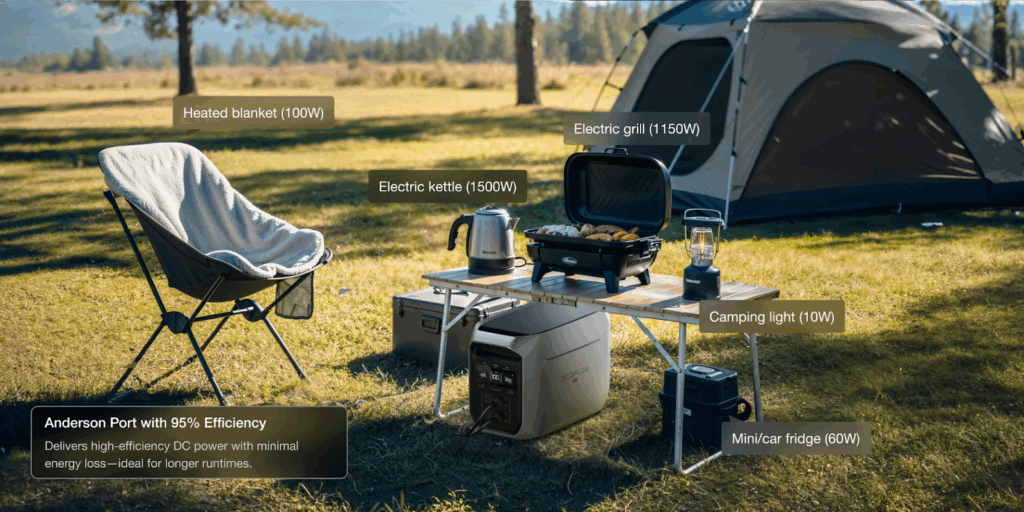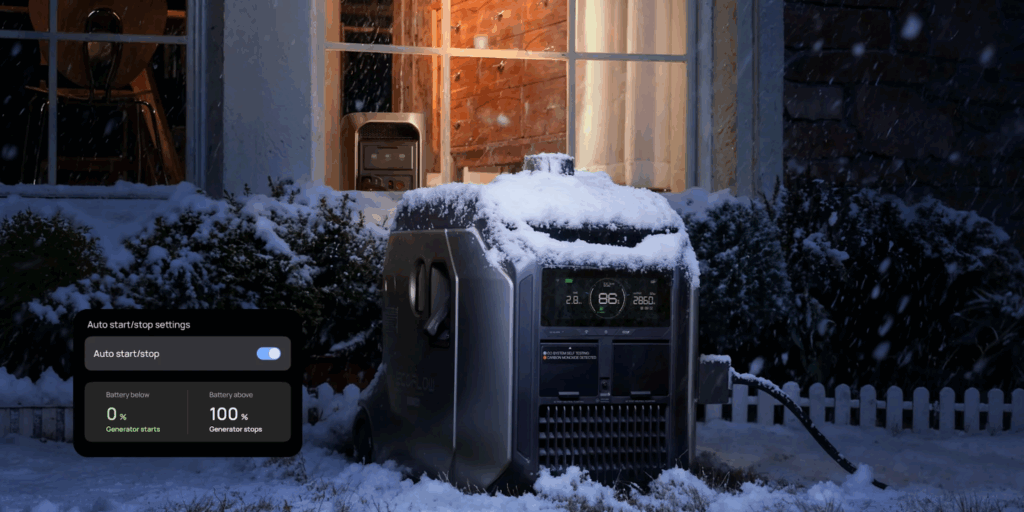Winter camping in Canada is breathtaking — silent forests, crisp air, and endless snow under a bright blue sky. But it also demands respect. Sub-zero temperatures test every piece of gear you bring, especially when it comes to power.
Staying warm, cooking safely, and keeping your devices charged can make or break a cold-weather trip. Whether you’re setting up basecamp in the Rockies or car camping near Algonquin, having a reliable energy plan — and the right power station — can mean the difference between comfort and survival.
1. Why Power Matters More in Winter
In summer, you might get by with a flashlight, a cooler, and a few spare batteries. But in winter, reliable electricity becomes essential for:
- Heating: Electric blankets, heated sleeping pads, or small ceramic heaters.
- Lighting: Long nights and short days mean extended use of headlamps and lanterns.
- Cooking: Electric kettles or induction stoves are safer than open flames in tight shelters.
- Safety and Communication: Phones, GPS units, avalanche beacons, and radios all need steady power.
Freezing temperatures also reduce battery efficiency — sometimes by 30–40%. That’s why it’s crucial to have a dependable power system built for cold conditions.
A well-chosen portable power station gives you the flexibility to run all these essentials safely and silently, even deep in the snow.
2. How Cold Affects Battery Performance
Every battery is made of chemical cells that rely on internal reactions to produce energy. In the cold, those reactions slow down, reducing both capacity and output power.
Here’s what typically happens below freezing:
- Batteries discharge faster.
- They take longer to recharge.
- Some may even shut down to prevent internal damage.
For traditional lithium-ion batteries, efficiency can drop sharply below 0 °C. That’s why outdoor enthusiasts are turning to LiFePO₄-based power stations — a newer battery chemistry that performs better in low temperatures and lasts thousands of cycles.
To keep your power system reliable:
- Store it inside your sleeping area or insulated bag when not in use.
- Avoid leaving it exposed to the snow overnight.
- Use a small hand warmer to keep the unit slightly above freezing if needed.
3. Choosing the Right Power Station for Winter
A winter-ready power setup doesn’t have to be complicated, but it does need to be dependable. When shopping for a power station, focus on these factors:
• Capacity (Watt-hours, Wh)
This tells you how much total energy you can store.
- 300–600 Wh: Lights, phones, cameras, and GPS.
- 1,000–1,500 Wh: Small heaters, cookers, or laptops.
- 2,000 Wh+: Power-hungry gear or longer off-grid trips.
• Output Power (Watts, W)
Make sure the unit can handle your highest-draw device. For example, an electric kettle may require 1,200 W, while an induction stove can need 1,800 W.
• Battery Type
Look for LiFePO₄ batteries — they’re more stable, safer in freezing weather, and deliver longer lifespans than traditional lithium-ion.
• Multiple Charging Inputs
Choose models that can recharge from wall outlets, vehicle DC ports, or solar panels. During multi-day trips, solar charging ensures independence when you’re far from civilization.
• Cold-Weather Operation Range
Check the manufacturer’s temperature specs. Some advanced power stations include built-in battery heaters to maintain performance down to –20 °C.
4. Solar Power in the Snow
You might think solar panels are useless in winter — but that’s not true. Cold air actually improves panel efficiency, and bright snow can reflect sunlight to increase total output.
To get the most from your setup:
- Clear panels of snow regularly. Even a thin layer blocks light.
- Adjust the tilt angle to face the low winter sun (steeper than summer).
- Pair panels with a power station that supports MPPT (Maximum Power Point Tracking) — this ensures optimal energy conversion even in low light.
A small 100–200 W solar panel kit can easily recharge a mid-sized battery during clear winter days, keeping your camp self-sufficient.
5. Powering Your Heating Equipment
Staying warm is your top priority in sub-zero conditions. While propane and wood stoves are common, electric heating can be a cleaner, safer supplement — especially inside a tent or RV.
You can use a power station to run:
- Electric blankets (50–100 W) — perfect for sleeping bags or layered under bedding.
- 12 V heated seat pads or vests (30–60 W) — keep you warm without open flames.
- Compact space heaters (200–500 W) — for enclosed spaces, though they drain batteries faster.
Always ventilate properly if combining electric and fuel heating. A well-sized power station can safely power low-watt devices for hours without noise, fumes, or carbon monoxide risk.

6. Lighting: The Comfort You’ll Appreciate
Long Canadian nights mean 14–16 hours of darkness in some regions. Good lighting isn’t just for visibility — it’s a morale booster.
To make your setup efficient:
- Use LED lanterns (5–10 W) — low draw, bright output.
- Keep headlamps charged for hands-free tasks.
- Hang string lights around your shelter for ambient warmth.
You can recharge all of these with a small power station or directly through its USB ports. Some campers even plug in dimmable LED strips for a cozy, cabin-like glow in their tents.
7. Cooking and Food Safety
Freezing weather makes cooking tricky — propane tanks lose pressure, and fire pits aren’t always allowed. Having reliable power opens safer options.
You can use your power station to run:
- Electric cookers or mini hotplates (600–1,000 W)
- Blenders or coffee makers (300–500 W)
- Electric coolers or mini-fridges (50–70 W) to keep food from freezing solid
Pro tip: Prepare semi-cooked or dehydrated meals at home. That way, you only need quick reheating — saving power and time in the cold.
8. Keeping Devices Charged and Functional
When you’re navigating snowy trails, communication is critical. Phones, GPS trackers, and radios are your lifelines.
A compact power station with multiple USB and DC ports can keep:
- Phones charged for mapping and weather updates.
- Cameras ready for capturing winter landscapes.
- Drones powered for aerial scouting.
Always carry short, thick charging cables — they’re more efficient in low temperatures. Store electronics close to your body during the day to prevent battery drain from the cold.
9. Managing Power Wisely
In freezing weather, energy conservation becomes a skill. Here’s how to extend runtime:
- Use low-power devices wherever possible.
- Cycle usage: run high-draw appliances one at a time.
- Dim lights and use warmer color settings.
- Keep batteries insulated: cold drains charge faster than use does.
- Monitor output: many power stations display exact usage and remaining hours.
If you’re traveling in a group, assign one person to track charging schedules so that everyone’s essentials — phones, GPS, lanterns — stay powered equally.
10. Safety Tips for Winter Power Use
- Keep power units dry: moisture and snow can cause short circuits. Use waterproof cases.
- Avoid direct floor contact: set the power station on a dry pad or insulated crate.
- Check cables frequently: cold can make plastic brittle.
- Never overheat or enclose batteries: ensure proper ventilation even in tents.
- Recharge daily: don’t wait until the battery is near empty — cold slows charging speed.
Preparedness keeps your camp both safe and comfortable, even in harsh conditions.
11. A Sample Setup for a 3-Day Winter Camp
Here’s an example of what a small group might bring:
| Equipment | Power Use (W) | Daily Hours | Energy Needed (Wh/day) |
| LED lights | 10 | 6 | 60 |
| Heated blanket | 80 | 4 | 320 |
| Electric kettle | 1,200 | 0.5 | 600 |
| Phones + GPS | 30 | 2 | 60 |
| Total | ≈1,040 Wh/day |
For a 3-day trip, a 1,500–2,000 Wh power station would comfortably handle all needs, with room to recharge via solar if conditions allow.
12. The Value of Quiet, Clean Energy
Traditional gas generators are impractical for winter camping — they’re heavy, noisy, and often unreliable in freezing temperatures. They also require constant ventilation and fuel storage, which can be dangerous inside tents or vehicles.
Battery-based power systems are silent, maintenance-free, and emission-free. A good power station provides dependable electricity without disturbing nature’s quiet or leaving a carbon footprint.
For eco-conscious campers, this is the future of outdoor energy — compact, efficient, and clean.
Conclusion
Winter camping in Canada is challenging, but with preparation, it’s one of the most rewarding outdoor experiences you can have.
By planning your energy needs, managing them wisely, and using a dependable power station designed for cold weather, you can keep the lights on, stay warm, and enjoy every frozen sunrise.
When temperatures drop, your power system becomes your lifeline — so choose it well, protect it from the cold, and it’ll keep your adventure bright no matter how low the thermometer falls.

